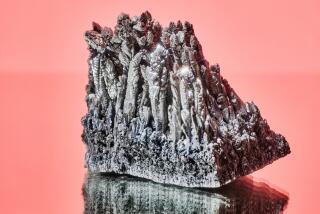Element 115 might earn an official spot on the periodic table
Element 115, scientists are on to you. Physicists at Lund University in Sweden announced Tuesday that they have new evidence that you exist.
Here’s what they said they know:
- You are “super-heavy.” But with 115 protons in your atomic nucleus, how could you not be?
- You are unstable. When they made you in a German research facility, you began to decay in a fraction of a second.
- You have secrets to tell about the “structure and properties” of the nucleus at the center of atoms of super-heavy elements like you. Details will be revealed shortly in a paper published in the journal Physical Review Letters.
Element 115 – which has a temporary name of ununpentium – was first created in 2003 in Russia by scientists from the Joint Institute for Nuclear Research in Dubna and collaborators from Lawrence Livermore National Laboratory in California. That team produced four atoms of ununpentium, which quickly lost two protons and decayed into element 113.
Those four short-lived atoms were years in the making. According to this explainer from Lawrence Livermore, it took more than a year to produce suitable “targets” made of the element americium-243, an isotope that contains 95 protons and 148 neutrons. Those targets were placed inside a cyclotron and bombarded with ions of calcium-48, a version of that element with 20 protons and 28 neutrons. When the calcium-48 ions collided into the americium-243 targets in just the right way, they created the new element with all 115 protons (plus a bunch of neutrons).
Four atoms of ununpentium were sufficient to claim a discovery, but they weren’t enough to make the element’s existence official. The tests that produced more ununpentium atoms in Germany might change that.
“This was a very successful experiment and is one of the most important in the field in recent years,” Dirk Rudolph, a Lund University professor of nuclear physics, said in a statement.
A committee from the International Union of Pure and Applied Chemistry will study the Lund report and decide whether to grant element 115 official status on the periodic table of elements. If that happens, the element will get a new name. (The folks at Lawrence Livermore noted that element 106 was discovered in 1974 but didn’t get its official name of seaborgium until 23 years later.)
Both of ununpentium’s neighbors on the periodic table have completed this vetting process. Element 114 was discovered in 1998 (also at the Joint Institute for Nuclear Research) and named Flerovium in 2012 in honor of the institute’s Flerov Laboratory of Nuclear Reactions. Element 116 was first created in 2000 and named Livermorium, in honor of the Lawrence Livermore National Laboratory, in 2012.
Scientists create these unstable, super-heavy elements because they can – they want to see if there’s a fundamental limit to the periodic table. But they also expect that as they synthesize heavier and heavier atoms, they’ll reach what they call the “island of stability” – a group of elements that can last for entire seconds or even minutes before their nuclei break apart and they decay into other elements.
[For the record, Sept. 27, 6:29 p.m.: An earlier version of this post said the first four atoms of ununpentium made by Russian and American scientists decayed to element 113 by losing two neutrons. The key is that it lost two protons.]
Return to Science Now.







